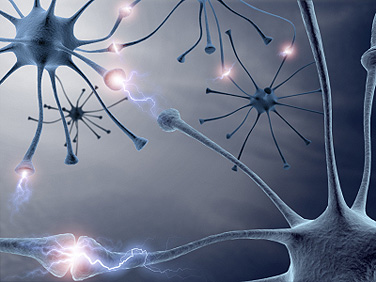News
Neuroscientists identify ion channels responsible for inflammatory pain

Targeting ion channels pharmacologically would offer effective pain relief without generating the side effects of typical painkilling drugs.
-
 Print
Print -
 Comments
(4)
Comments
(4)
-
“The need to understand pain mechanisms remains paramount for human health and for society.”
UB neuroscientists conducting basic research on ion channels have demonstrated a process that could have a profound therapeutic impact on pain.
Targeting these ion channels pharmacologically would offer effective pain relief without generating the side effects of typical painkilling drugs, according to a paper published by the researchers in a recent issue of The Journal of Neuroscience.
“Pain is the most common symptom of injuries and diseases, and pain remains the primary reason a person visits the doctor,” says Arin Bhattacharjee assistant professor of pharmacology and toxicology in the School of Medicine and Biological Sciences, director of the Program in Neuroscience and senior author on the paper.
“Fifty million Americans suffer from chronic pain, costing between $100-200 billion a year in medical expenses, lost wages and other costs,” says Bhattacharjee. “The need to understand pain mechanisms remains paramount for human health and for society.”
Inflammatory pain can result from penetration wounds, burns, extreme cold, fractures, arthritis, autoimmune conditions, excessive stretching, infections and vasoconstriction.
“There are efficacious treatments for inflammatory pain, such as corticosteroids and non-steroidal anti-inflammatory drugs,” says Bhattacharjee, “but the adverse side effects associated with these drugs limit their long-term use and compromise patient compliance. As a result, there is a great need to understand the cellular processes involved in inflammatory pain to create less toxic, less addictive, analgesic drugs.”
Pain-responsive nerve cells, known as nociceptors, are electrical cells that normally respond to pain stimuli. Nociceptors then relay information to the central nervous system, indicating the location, nature and intensity of the ensuing pain. Nociceptors are sensitized during inflammation, their ionic properties are altered and their firing characteristics change. This sensitization causes a state of “hyperalgesia,” or increased sensitivity to pain.
“Merely touching the inflamed area can be very painful,” notes Bhattacharjee. “The ionic mechanisms that are chiefly responsible for this inflammatory-mediated change in nociceptive firing had not been clearly identified.
“We were able to demonstrate that a certain class of potassium channels is removed from the surface of nociceptive cells during inflammatory signaling. The removal of these ion channels is linked to the hypersensitivity of these nerve cells. We demonstrated that reducing the expression of these channels by gene interference techniques produced a similar nociceptor hyperexcitability.”
Bhattacharjee says his team plans to extend its ion-channel “trafficking” studies to in vivo models, using peptide inhibitors to try to prevent the removal of the potassium channels from the surface of nociceptors during inflammation.
“We expect to show that maintaining these channels at the surface during inflammation will be effective for pain relief. Successful completion of our studies will provide the impetus for direct human clinical trials,” he says.
Megan O. Nuwer and Kelly E. Picchione, both in the neuroscience program, are co-authors on the paper.
The study was supported by a Junior Faculty Award from the American Diabetes Association and a John R. Oishei Foundation Grant to Bhattacharjee.

Reader Comments
Megan K says:
this is my intended major so reading this further encourages me to proceed with my current plan. This article was very exciting and informational. Its amazing what science can help us understand.
Posted by Megan K, Student, 02/07/11
Reninger Flores says:
As a person related with patients suffering paifull situations daily, this research seems to me very encouraging. I hope Bhattacharjee and his team,preety soon they can confirm the right replacement of today painkillers without the horrific side effects in our patients.
Posted by Reninger Flores, CRC student , 02/06/11
Michael Bozarth says:
I haven't read the actual publication in The Journal of Neuroscience yet, but if Ms. Baker's article in the UB Reporter is accurate, then this is very exciting indeed. The key will be whether a special class of potassium receptors are specific for nociception and ONLY for nociception. What limits the clinical application of a lot of good basic research today is often the same receptor subtype mediates many different effects and thus prevents selective drug action for just a single target effect. In any case, well done and I look forward to following this story.( For my PSY451 and PSY486 students who read this article, note how "sensitization" works its way into this process as well as the processes we study in behavioral pharmacology.)
Posted by Michael Bozarth, Associate Professor/Psychology, 02/03/11
Price says:
Very exciting, I think. I am only a freshman student, and as a psychology major with interests in medicine, this is very interesting. I only wish there were more groups of students participating in such interesting research.
Posted by Price , Student, 02/03/11